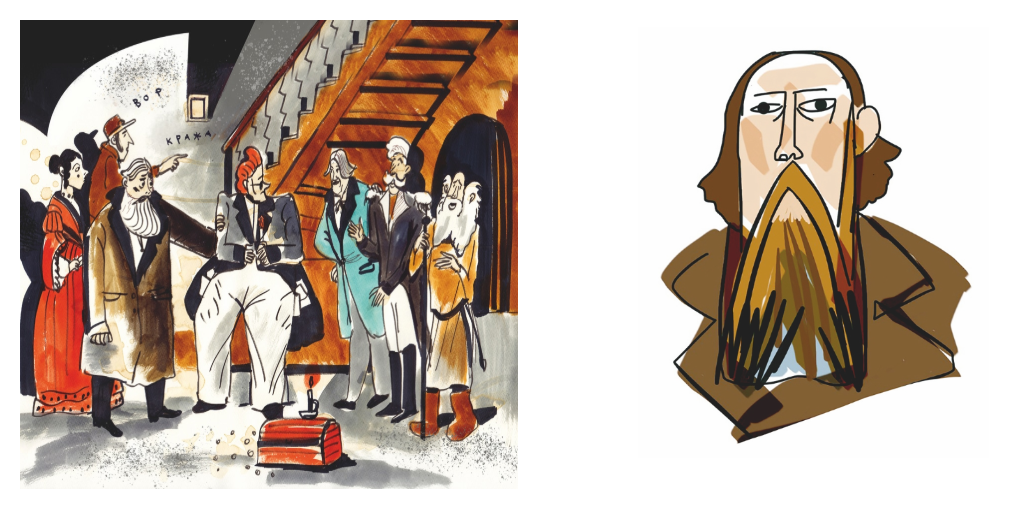"The Death of Pazukhin" (1857)

"The Death of Pazukhin" by Mikhail Saltykov-Shchedrin
Mikhail Saltykov-Shchedrin is better known to modern readers as a brilliant writer rather than a playwright. By the satirist's own admission, he never harbored any particular fondness or trust for the theatrical stage. However, drama always attracted Shchedrin with its expressiveness—his Provincial Sketches contain both monologues and dramatic scenes. It was in this work that Shchedrin intended to include a play titled Death, later renamed “The Kingdom of Death”, and then “The End Crowns the Deed". The text was never finalized, but from the drafts of the first act emerged an independent work—”The Death of Pazukhin”.
“The Death of Pazukhin” is one of the most flawless works of satirical drama. The story of a thief trying to swindle another thief did not sit well with theatrical censors. The play was banned because it openly depicted the moral decay of society.
The greedy old man Pazukhin has made a huge fortune through deceit and fraud. His relatives have spent years in eager anticipation of the death of their detested relative, each with their own views on the inheritance. Around these millions unfolds a veritable detective story, rife with betrayal, deception, cruelty, hypocrisy, scandals, and intrigue. The old man’s relatives are prepared to betray the most sacred bonds and trample all moral norms—just to get their hands on the money. The play’s characters weave cunning schemes, attempt to outmaneuver their rivals, expose thieves, and file police reports, proving in word and deed that the apple doesn’t fall far from the tree. The author wryly notes that Pazukhin’s sudden demise is triggered by the news that he has been denied the rank of Nadvorny Sovetnik (a mid-level bureaucratic rank, like the State Councillor). The selfish old man cannot bear this blow and departs prematurely for the afterlife—committing one final and most significant act of spite by leaving no will behind.
A key focus of Saltykov-Shchedrin’s play is the phenomenon of inheritance law in the Russian Empire during the second half of the 19th century. Legislation provided for two forms of inheritance: by will and by statutory succession.
The procedure for obtaining inheritance by will was governed by the Statute on Spiritual (Ecclesiastical) Testaments, which recognized two main categories:
Formal (notarized) wills – serf transactions conducted with the involvement of public authorities in the district court, magistrate, or the civil chamber;
Holographic (private) wills – drawn up by the testator at their place of residence.
Russian law imposed no restrictions on a testator’s freedom to designate beneficiaries, which explains the intense interest of Saltykov-Shchedrin’s satirical characters in securing the "spiritual" (i.e., last will) of Podkhalyuzin.
In the play, inheritance was realised by law rather than by will. The merchant’s son becomes the sole legal heir. Under Russian law at the time, women gained equal inheritance rights with men only in 1912; thus, the deceased’s daughters received merely their statutory share: 1/14 of real property and 1/8 of movable property.
The plot gives particular attention to matters of criminal law, exemplified by the episode involving the merchant's son-in-law's attempted theft of property. Punishment for such crimes and misdemeanors was defined by Article 2150 of the Penal and Correctional Punishments Code of 1845 или The Criminal Code of 1845 (Уложение о наказаниях уголовных и исправительных).
The offender faced deprivation of all property rights and exile to Siberia. The son-in-law Podkhalyuzin, a State Councilor (статский советник) Furnalchev, was caught red-handed at the crime scene in the presence of witnesses. The legal heir declines to prosecute, seeking only to ruin the reputation of his mercenary relative.
M.E. Saltykov-Shchedrin continues Gogol's tradition of satirical laughter, exposing human vices with particular wit. The final line underscores the farcical nature of events: “Gentlemen! The performance is over! Virtue... pah! Vice has been punished, but virtue... where is this virtue anyway?!"
Signs and Symbols in the Illustration
Hereditary law in the Russian Empire in the second half of the 19th century